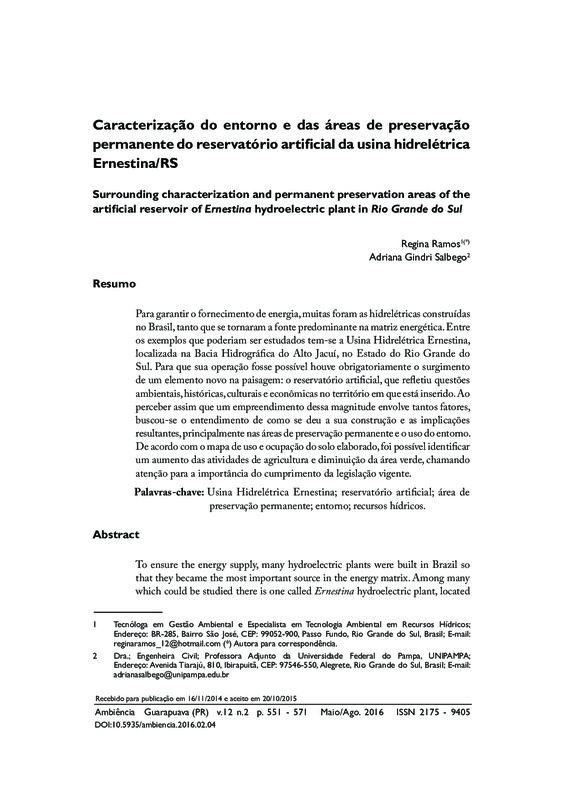Caracterização do entorno e das áreas de preservação permanente do reservatório artificial da usina hidrelétrica Ernestina/RS Surrounding characterization and permanent preservation areas of the artificial reservoir of Ernestina hydroelectric plant in Rio Grande do Sul
Item
-
Título
-
Caracterização do entorno e das áreas de preservação permanente do reservatório artificial da usina hidrelétrica Ernestina/RS Surrounding characterization and permanent preservation areas of the artificial reservoir of Ernestina hydroelectric plant in Rio Grande do Sul
-
AMBIÊNCIA
-
UNIPAMPA
-
Autor
-
Regina Ramos
-
Adriana Gindri Salbego
-
Assunto
-
Usina Hidrelétrica Ernestina
-
entorno
-
recursos hídricos
-
reservatório artificial
-
área de preservação permanente
-
Abstract
-
Para garantir o fornecimento de energia, muitas foram as hidrelétricas construídas no Brasil, tanto que se tornaram a fonte predominante na matriz energética. Entre os exemplos que poderiam ser estudados tem-se a Usina Hidrelétrica Ernestina, localizada na Bacia Hidrográfica do Alto Jacuí, no Estado do Rio Grande do Sul. Para que sua operação fosse possível houve obrigatoriamente o surgimento de um elemento novo na paisagem: o reservatório artificial, que refletiu questões ambientais, históricas, culturais e econômicas no território em que está inserido. Ao perceber assim que um empreendimento dessa magnitude envolve tantos fatores, buscou-se o entendimento de como se deu a sua construção e as implicações resultantes, principalmente nas áreas de preservação permanente e o uso do entorno. De acordo com o mapa de uso e ocupação do solo elaborado, foi possível identificar um aumento das atividades de agricultura e diminuição da área verde, chamando atenção para a importância do cumprimento da legislação vigente.Abstract To ensure the energy supply, many hydroelectric plants were built in Brazil so that they became the most important source in the energy matrix. Among many which could be studied there is one called Ernestina hydroelectric plant, located in Alto Jacuí hydrographic basin, in the state of Rio Grande do Sul. In order to make the undertaking feasible, a new element in the hydrographic basin landscape had to be built: an artificial reservoir which had an impact on the economical, cultural, historical and environmental characteristics of the area. By realizing that an undertaking of this magnitude involves many factors, this study aimed at analyzing how the construction happened and its resulting implications, mainly in the areas of permanent preservation and in the surrounding area. According to the map of use and occupation of the prepared soil, it was possible to identify an increase in agricultural activities and reduction of green area, drawing attention to the importance of compliance with current legislation.
-
volume
-
12
-
issue
-
2
-
Páginas
-
551-571
-
Date
-
2016
-
Língua
-
pt
-
issn
-
2175-9405
-
Rights
-
Direitos autorais 2016


